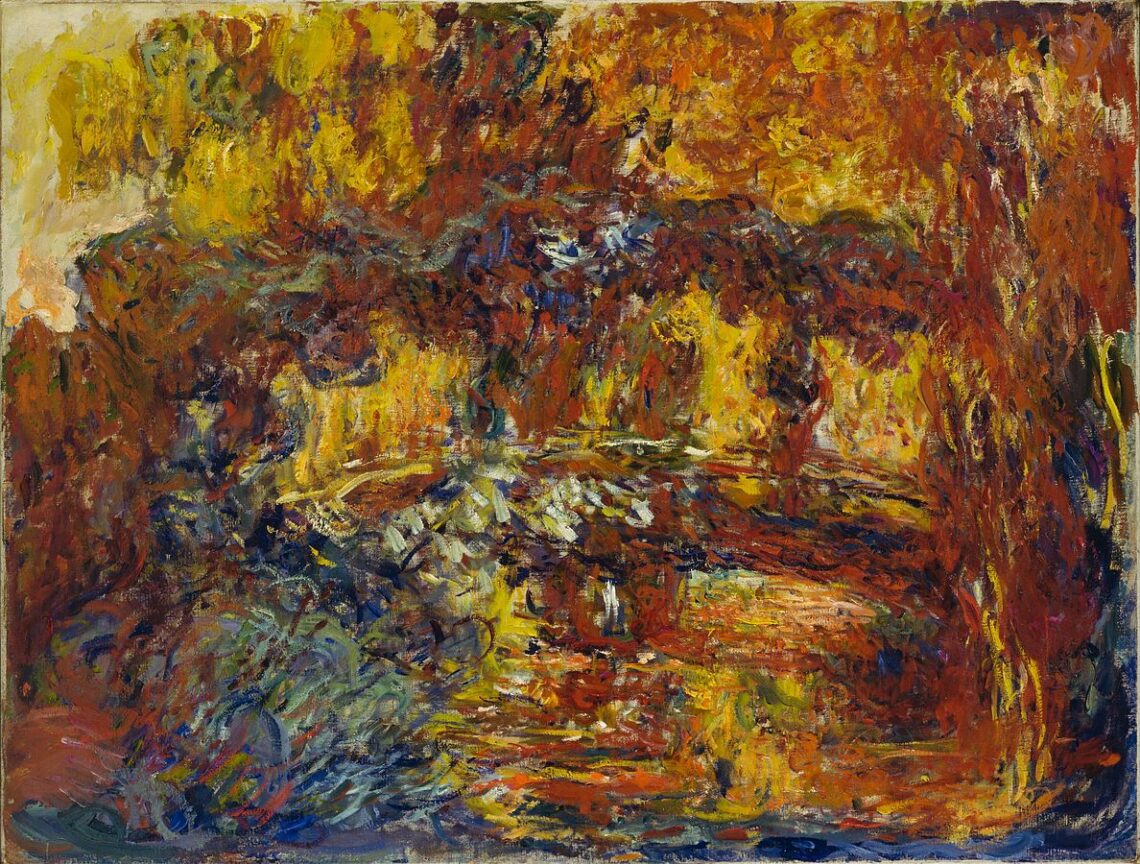Claude Monet was one of the first impressionists, and the paintings he completed at his house in Giverny are some of his most beloved works. Towards the end of his life, Monet developed cataracts in both his eyes, leading to a departure from his bright, soothing color palette into the more rich, robust colors seen in The Japanese Footbridge. Singulart explores the influence that Monet’s paintings had on his style, as well as how his use of color developed over time.
Monet’s gardens in Giverny

Monet and his family moved to Giverny in 1883. His credibility as an artist was steadily increasing, and by 1890, he earned enough through selling his paintings to purchase the house outright. Monet dedicated considerable time to design and maintain the gardens, hiring six gardeners to assist him. As his earnings built up, he continued to expand the gardens, including the famous lily garden that would feature in numerous future paintings.
Local white lilies were planted alongside plants imported from South America and Egypt. According to a Normandy tour guide, one of the gardeners had the not-so-pleasant job of preventing the water rats from eating the lilies, as well as fishing out the dead flowers from the pond. Monet was so set on having his pond that he illegally directed an arm of the Epte River into his gardens, to the ire of the local community. He narrowly avoided a fine with the help of his friend, journalist and future Prime Minister George Clemenceau.
Monet remained in his Giverny house until his death in 1926. The gardens are still open for the public to view the source of one of Monet’s greatest inspirations.
The Japanese Footbridge
The Japanese Footbridge was one of Monet’s last paintings. While other artworks in his Giverny series were painted in his usual impressionist style, The Japanese Footbridge is almost abstract, with swirling brushstrokes forming a bridge in a range of autumnal hues. It has been suggested that Monet adapted his style when his eyesight began failing due to cataracts, hence the difference between The Japanese Footbridge seen here compared to the more naturalistic depictions painted when he first moved to Giverny. This could also be the driving force behind his choice to use a stronger color palette. Monet forgoed his use of meticulous, tiny brushstrokes in order to liberally apply paint onto the canvas.

While the painting reflects the bridge with trailing wisteria, most likely maintained by one of the six gardeners Monet hired, it is less realistic than his other works. Monet was most likely working from memory to evoke a certain emotion, as was common for the impressionist movement.
The color palette of Monet
Throughout his career, Monet relied heavily on the use of color, as impressionists did not tend to use much defined line work in their pieces. He stated:
“As for the colors I use, what’s so interesting about that? I don’t think one could paint better or more brightly with another palette. The most important thing is to know how to use the colors. Their choice is a matter of habit. In short, I use white lead, cadmium yellow, vermillion, madder, cobalt blue, chrome green. That’s all.”
By 1886, Monet had ceased to use black in any of his pieces. Even shadows are rendered in a purple hue. Monet used light or white colored canvases, providing a simple background for the opaqueness of his paint and giving focus to his liberal use of color.
In his paintings from 1908 onward, it becomes apparent that Monet’s eyesight was deteriorating, due to cataracts he developed in both eyes. He wrote, “My bad sight means that I see everything through a mist… Even so it is beautiful, and that is what I would like to show.” Clemenceau convinced Monet to undergo surgery, and he regained vision in his right eye. His left eye, however, never recovered, and his works from 1923 onward reflect the effect of his surgery; through his left eye, colors seemed red or yellow, and through his right eye, everything was tinted with blue. He wrote:
“I see blue, I don’t see red anymore, nor yellow; this bothers me terribly because I know that there is a red, yellow, a special green, a particular purple on my palette; I don’t see them anymore as I used to see them in the past, and however I remember very well what it was like.”















